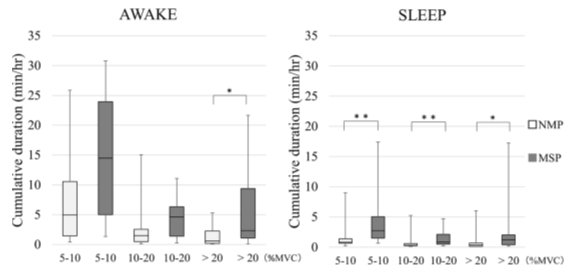
Periodontitis is an infection of the gum (the flesh around the roots of teeth in the upper and lower jaws), damaging jaw tissue and ultimately destroying the bone holding teeth in place, resulting in tooth loosening and loss. Medical researchers have been investigating the relationship between periodontitis and the activity of the masseter muscles — the main muscles involved in the process of chewing. Specifically, it has been unclear whether involuntary teeth grinding and jaw clenching, a condition known as bruxism, is related to periodontitis and its development. Now, Professor Shogo Minagi and Dr. Seiya Kato from Okayama University and colleagues have performed detailed measurements of masseter muscle activity in a group of people with various degrees of periodontal disease, and found that non-functional teeth grinding might be related to the acuteness of periodontitis.
Bruxism not only occurs when a person is awake, but also when sleeping. Therefore, the researchers made sure to design the study so that it provides information on masseter muscle activity over a long-enough period (daytime followed by night-time). A group of 31 people was selected; 16 of them had no or mild periodontitis (the ‘NMP’ group), while 15 had moderate to severe periodontitis (the ‘MSP’ group).
Each individual was equipped with an ambulatory portable device measuring muscle activity via a technique known as surface electromyography. (The technique involves placing electrodes on the skin lying over the muscle; muscular motion triggers an electrical signal which is recorded.) Participants of the study had to maintain a diary noting their activities including eating meals, which helped the researchers analyzing the data and filtering out muscular activity not coming from involuntary teeth grinding. Teeth movement due to speech was filtered out by monitoring voice activity by a microphone attached to the electrodes.
Professor Minagi and colleagues found that there are differences in masseter muscle activity between the NMP and MSP groups: the accumulated duration of non-functional (i.e. not related to eating or talking) high-intensity muscle motion was significantly longer for the participants from the MSP group. The finding applies to both awake and asleep regimes. The scientists concluded that “masseter muscle activity might be related to the severity of periodontitis”, but they stress that causation — bruxism leading to periodontitis — cannot be concluded from the study. They also point to limitations of their study: oral conditions like missing teeth or the use of removable partial dentures not being taken into account, and the limited capabilities of the ambulant surface electromyography setup.
Background
Bruxism. Periodontitis
Bruxism is the term for non-functional, habitual teeth grinding or jaw clenching. (Eating and talking are functional activities.) Two types of bruxism are distinguished: when a person is asleep (nocturnal bruxism) and when awake. Symptoms typically associated with both types of bruxism include hypersensitive teeth, headaches, damage to dental fillings and tooth wear.
It is an open question whether there is a relationship between bruxism and periodontal disease — the gum infection damaging soft tissue surrounding teeth and destroying the bones supporting them. Periodontitis is a common disease, but can be prevented, mainly by observing good oral hygiene — daily brushing and flossing teeth combined with regular dental checkups.
Professor Minagi and Dr. Kato from Okayama University and colleagues have now investigated the potential relationship between bruxism and periodontitis, by monitoring teeth grinding activity of people at different stages of periodontal disease. They found that muscular teeth-grinding motion might be related to the severity of the disease.
Electromyography
Electromyography (EMG) is a medical technique used for recording the electrical activity resulting from skeletal muscle activity. EMG involves an instrument called an electromyograph, which produces data in the form of a so-called electromyograph. In surface EMG, the electrodes that pick up the electrical activity are placed onto the skin, as opposed to intramuscular EMG, where electrode needles are inserted directly into the muscle, under the skin.
Professor Minagi and colleagues used surface EMG — which does not hurt as there is no need to pierce the skin — to detect activity of the masseter muscle in a group of people suffering from periodontitis at various levels of severity. The design of their medical study enabled monitoring muscle activity for long periods of time (roughly a daily cycle) and helped to provide insights into the relationship between involuntary teeth grinding (bruxism) and the degree of periodontitis.
About Okayama University
Okayama University is one of the largest comprehensive universities in Japan with roots going back to the Medical Training Place sponsored by the Lord of Okayama and established in 1870. Now with 1,300 faculty and 13,000 students, the University offers courses in specialties ranging from medicine and pharmacy to humanities and physical sciences. Okayama University is located in the heart of Japan approximately 3 hours west of Tokyo by Shinkansen.




